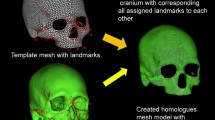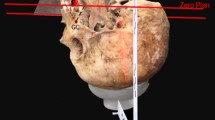Abstract
A new coordinate system for primate skulls was defined by the orbital axis and the validity of the system was examined. This system is thought to be equivalent throughout the primates. With the aid of photogrammetry the three-dimensional coordinates of 39 points on the skulls of 479 individuals comprising 54 species including man were accurately measured. The orbital structure is morphologically stable and its axis represents a comparative horizontal. The midsagittal plane and the bilateral symmetry of the cranium are also stable. The morphological stability in angular dimensions is confirmed by a standard deviation smaller than 2.0°. The major evolutionary change in the neurocranium is the inclination of the cranial base from the orbital horizon, and the inclination is related to the neurocranial size. The ear-eye plane is generally inapplicable to the primates, because it is affected by the orbital size and the descent of the auricular part due to the inclination of the cranial base. The clivus line or the vestibular coordinate system is not desirable as the horizontal, either. The evolutionary development of the facial part of the cranium is independent of that of the neurocranium and these two parts are separated by the orbital horizon.
Similar content being viewed by others
References
Abbie, A. A., 1963. The cranial centre.Z. Morph. Anthropol., 53: 6–11.
Angst, R., 1967. Beitrag zum Formwandel des Craniums der Ponginen.Z. Morph. Anthropol., 58: 109–151.
————, 1968. Über die Variabilität und Veränderungen der präbasialen Kyphose während der postnatalen Ontogenese bei Colobinenschädeln.Folia Primatol., 8: 301–306.
Ashton, E. H. &S. Zuckerman, 1952. Age changes in the position of the occipital condyles in the chimpanzee and gorilla.Amer. J. Phys. Anthropol., 10: 277–288.
———— & ————, 1956. Age changes in the position of the foramen magnum in hominoids.Proc. Zool. Soc., Lond., 126: 315–325.
———— &T. F. Spence, 1958. Age changes in the cranial capacity and foramen magnum of hominoids.Proc. Zool. Soc., Lond., 130: 169–181.
Benfer, R. A., 1975. Morphometric analysis of cartesian coordinates of the human skull.Amer. J. Phys. Anthropol., 42: 371–382.
Biegert, J., 1957. Der Formwandel des Primatenschädels und seine Beziehungen zur ontogenetischen Entwicklung und den phylogenetischen Spezialisationen der Kopforgane.Morph. Jb., 98: 77–199.
————, 1963. The evaluation of characteristics of the skull, hands and feet for primate taxonomy. In:Classification and Human Evolution,S. L. Washburn (ed.), Viking Fund Publ., Anthropol., Chicago, pp. 116–145.
Bolk, L., 1915. Über Lagerung, Verschiebung und Neigung des Foramen magnum am Schädel der Primaten.Z. Morph. Anthropol., 17: 611–692.
Cartmill, M., 1970. The orbits of arboreal mammals: a reassessment of the arboreal theory of primate evolution. Ph.D. thesis, Univ. of Chicago, Chicago.
Clark, W. E. Le Gros, 1963.The Antecedents of Man. Harper & Row, New York.
Conroy, G. C., 1981. Cranial asymmetry in ceboid primates: the emissary foramina.Amer. J. Phys. Anthropol., 55: 187–194.
Creel, N. &H. Preuschoft, 1976. Cranial morphology of the lesser apes: A multivariate statistical study. In:Gibbon and Siamang, Vol. 4,D. M. Rumbauch (ed.), S. Karger, Basel, pp. 219–303.
———— & ————, 1981. Homonoid taxonomy: A canonical analysis of cranial dimensions.Proceed. 3rd Int. Congr. Primatol., Zurich 1970, 1, pp. 36–43.
Dabelow, A., 1929. Über Korrelationen in der phylogenetischen Entwicklung der Schädelform I. Die Beziehungen zwischen Rumpf und Schädelform.Morph. Jb., 63: 1–49.
————, 1931. Über Korrelationen in der phylogenetischen Entwicklung der Schädelform II. Beziehungen zwischen Gehirn und Schädelbasis bei den Mammalien.Morph. Jb., 67: 84–133.
Delattre, A. &R. Fenart, 1963. Etude des projections horizontale et verticofrontale du crane au cours de l'hominisation.L'anthropologie, 67: 525–561.
Dmoch, R., 1975. Beiträge zum Formwandel des Primatencraniums mit Bemerkungen zu den sagittalen Knickungsverhältnissen.Gegenb. Morph. Jb., 121: 450–491; 521–601; 625–668.
————, 1976. Beiträge zum Formwandel des Primatencraniums mit Bemerkungen zu den sagittalen Knickungsverhältnissen.Gegenb. Morph. Jb., 122: 1–81.
Frick, H., 1960. Über die Variabilität der präbasialen Kyphose bei Pavianschädeln.Z. Anat. Entwicklungsgesch., 121: 446–454.
Gabow, S. L., 1977. Population structure and the rate of hominid brain evolution.J. Human Evol., 6: 643–665.
Goldstein, M. S., 1936. Changes in dimensions and form of the face and head with age.Amer. J. Phys. Anthropol., 22: 37–89.
Hofer, H., 1952. Der Gestaltwandel des Schädels der Säugetiere und Vögel, mit besonderer Berücksichtigung der Knickungstypen und Schädelbasis.Verh. Anat. Ges., 50. Vers. Marburg, Anat. Anz. Erg-Heft, 102–103.
————, 1954. Die kranio-cerebrale Topographie bei den Affen und ihre Bedeutung für die menschliche Schädelform.Homo, 5: 52–72.
----, 1957. Zur Kenntnisse der Kyphosen des Primatenschädels.Verh. Anat. Ges., 54. Vers. Freiburg (i. Br., Suppl.),Anat. Anz. Erg-Heft, pp. 54–76.
————, 1960. Studien zum Problem des Gestaltwandels des Schädels der Säugetiere, insbesondere der Primaten I. Die Medianen Krümmungen des Schädels und ihre Erfassung nach der Methode vonLandzert.Z. Morph. Anthropol., 53: 299–316.
————, 1965. Die morphologische Analyse des Schädels des Menschen. In:Menschiliche Abstammungslehre,G. Heberer (ed.), Gustav Fischer, Stuttgart, pp. 145–226.
Jacobshagen, B., 1980. Grenzen konventioneller Techniken und Möglichkeiten alternativer Ansätze in der Anthropometrie.Z. Morph. Anthropol., 71: 306–321.
————, 1981. Comparison of morphological factors in the cranial variation of the great apes and man. In:Primate Evolutionary Biology,A. B. Chiarelli &R. S. Corruccini (eds.), Springer, Berlin, pp. 98–108.
Jungers, W. L. &R. Z. German, 1981. Ontogenetic and interspecific skeletal allometry in nonhuman primates: Bivariate versus multivariate analysis.Amer. J. Phys. Anthropol., 55: 195–202.
Kummer, B., 1952a. Untersuchungen über die Entstehung der Schädelbasisform bei Mensch und Primaten.Verh. Anat. Ges., 50. Vers. Marburg, Anat. Anz. Erg-Heft, pp. 122–126.
————, 1952b. Untersuchungen über die ontogenetische Entwicklung des menschlichen Schädelbasiswinkels.Z. Morph. Anthropol., 43: 331–360.
————, 1957. Zur Frage der Orientierung von Primatenschädeln zum morphologischen Formvergleich.Anthropol. Anz., 20: 283–290.
Martin, R. & K. Saller, 1957.Lehrbuch der Anthropologie, 3 Aufl., Gustav Fischer, Stuttgart, Band I.
Moore, W. J., L. M. Adams &C. L. B. Lavelle, 1973. Head posture in the Hominoidea.J. Zool., London, 169: 409–416.
Oyen, O. J. &A. Walker, 1977. Stereometric craniometry.Amer. J. Phys. Anthropol., 46: 177–182.
Schultz, A. H., 1940. The size of the orbit and of the eye in primates.Amer. J. Phys. Anthropol., 26: 389–408.
————, 1942. Conditions for balancing the head in primates.Amer. J. Phys. Anthropol., 29: 484–497.
————, 1955. The position of the occipital condyles and of the face relative to the skull base in primates.Amer. J. Phys. Anthropol., 13: 97–120.
Starck, D., 1965. Some remarks on morphological problems of the baboon skull (skull base, development of the skull, variability in homogeneous populations). In:The Baboon in Medical Research,H. Vagdborg (ed.), Univ. of Texas Press, Austin, pp. 181–190.
Suwa, G., 1981a. Fundamental characteristics of the vestibular coordinate system in human craniology.J. Anthropol. Soc. Nippon, 89: 303–328.
————, 1981b. A morphological analysis of Japanese crania by means of the vestibular coordinate system.J. Anthropol. Soc. Nippon, 89: 329–350.
Vogel, C., 1966.Morphologische Studien am Gesichtsschädel Catarrhiner Primaten. Bibliotheca Primatologica, Vol. 4.
Weidenreich, F., 1924. Die Sonderform des Menschenschädels als Anpassung an den aufrechten Gang.Z. Morph. Anthropol., 24: 157–190.
Author information
Authors and Affiliations
About this article
Cite this article
Matsumoto, S. A new coordinate system using the orbital axis for morphological analysis of primate skulls. Primates 24, 546–566 (1983). https://doi.org/10.1007/BF02381688
Received:
Accepted:
Issue Date:
DOI: https://doi.org/10.1007/BF02381688




